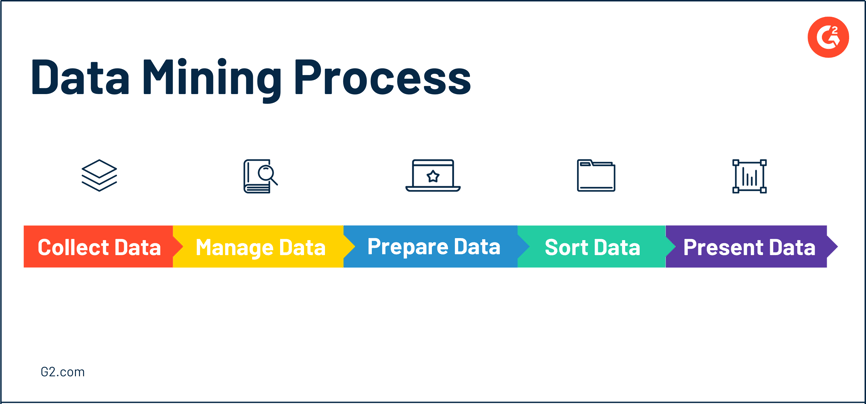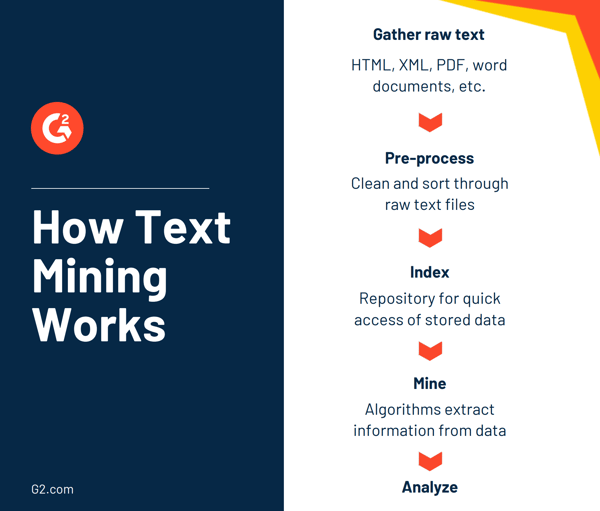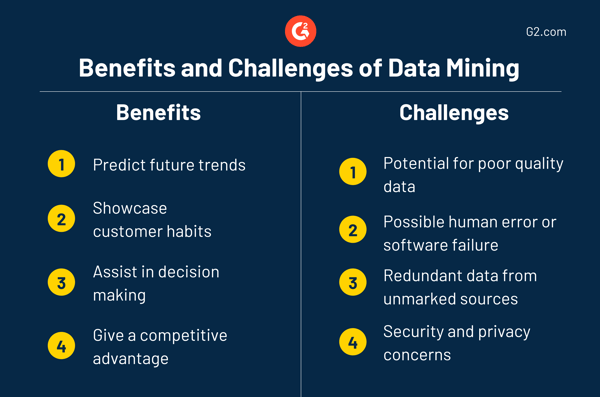

Brittany Kaiser, former Director of Business Development for Cambridge Analytica, stated in Netflix’s The Great Hack that data is now more valuable than oil.
And just like oil, gold, ore, and other natural resources, there’s hidden value in data that needs to be mined and extracted using machine learning software. This process is referred to as data mining.
Data mining is the process of finding anomalies, correlations, and patterns in large datasets to identify patterns, extract useful insights, and predict outcomes.
Data mining uses data collection, data warehouses, and computer processing to uncover patterns, trends, and other truths about data that aren’t initially visible using machine learning, statistics, and database systems.
While this term is relatively new (first coined in the 1990s), it’s becoming more common as organizations across all industries are using it to gain further insight about how they can better their businesses.
Having structured and unstructured data doesn't necessarily provide you with the insights or knowledge you need. That's where data mining comes in as it lets you The discover patterns and relationships in large data volumes from multiple sources.
Data mining is useful because it enables you to:
Data mining explores a business’s historical data during the data analysis process to look at past performances or future forecasts. This leads to faster, more efficient decision making.
For example, through data mining, a business may be able to see which customers are buying specific products at certain times of the year. This information can then be used to segment those customers. Customer segmentation is important for targeting sales and marketing campaigns – which may lead to higher profits, but also point toward a potential trend or two.
In addition to automated decision-making, data mining is also an important tool because it can accurately predict and forecast trends for your business based on historical information and current conditions. It also has the capability to allow for more efficient use and allocation of resources so that businesses can plan and make automated decisions to maximize cost reduction.
The process of data mining consists of exploring and analyzing large sums of information with the intention of discovering meaningful patterns and trends. Doing so is essentially broken down into a five step process.

Going through this process doesn’t help anyone if the data you collect goes untouched. The right business intelligence tool breaks down the data to a granular level, allowing your team to dig into the data to create forecasts, strategies, and actionable insights.
Data mining uses different techniques such as association rules, clustering, decision trees, neural networks, predictive analysis, and K-Nearest neighbor (KNN) to find useful insights from data.
Here’s an example of how text mining works:

Text-heavy data will first need to be collected and formatted in a uniform way. Text is taken from everything to HTML and XML files to word documents and PDF files using text analysis software. Then embedded image files will be deleted as they serve no value in regards to text mining.
Next, all text that is considered “noise” will be eliminated. This consists of words like “of,” “a,” “the,” and so on.
Words that are synonyms will be unified. Numerical values and percentages will be pulled and formatted in their own ways. Phrases, key terms, sentence structures, and other nuances of the human language will be broken down as well. Now, everything should be as close to structured data as possible.
The Cross-Industry Standard Process for Data Mining (CRISP-DM) designed a six-phase, flexible workflow that data teams can use to accelerate data mining tasks. Following this data mining stages allows data analysts to have a structure for their work and adhere to preparatory steps.
Below are the six CRISP-DM phases you can follow for data mining.
1. Business understanding: Analysts must start by understanding the project objective and scope before cleaning, extracting, or analyzing data. Start by asking questions like: what are the goals of this data mining activity? what strengths, weaknesses, opportunities, and threats does the SWOT analysis reveal? What is the current business situation and what does success look like?
2. Data understanding involves collecting relevant structured and unstructured data from different sources. During this stage, you will also need determine the final outcome that you wish to achieve and how you plan to store data. Also, consider how data collection, storage, and security may impact the data mining process. At the end, you may want to conduct exploratory analysis to uncover preliminary data patterns.
3. Data preparation: This data mining stage involves using data preparation tools to finalize the dataset. While preparing data, you must check the dataset for outliers, entry errors, and other mistakes. Ideally, you should also evaluate whether the dataset is unnecessarily oversized, which may hinder the computation process.
4. Data modeling: Once you have the final dataset, you can start choosing appropriate data modeling and analysis techniques. Your choice of a data model is largely dependent on the relationships or patterns you wish to find. Data analysts may revisit the data preparation stage in case they decide to use a model that requires more variables than what they currently have.
5. Evaluation: This stage of the data mining process involves testing the model you built and measuring whether it can successfully deliver what you need. Based on testing results, you may need to optimize the model. The evaluation phase is a crucial checkpoint helping you understand whether you're heading in the right direction of achieving business goals with the data model.
6. Deployment: The final phase of the data mining process involves deploying the model within the organization or outside. Ideally, you should create a rollout plan to help different audiences understand the goal of the data mining model, how it works, and how it tackles business problems.
Businesses across a variety of industries are turning to data mining to gain insights in ways that were once impossible. Below are some examples of how data mining is changing businesses for the better.
Businesses within the marketing industry use data mining to analyze large sums of data to improve marketing segmentation. For instance, when looking at parameters like customer age, gender, location, or other demographic information, data mining makes it possible to guess their customers’ behavior as a direct correlation of these parameters.
It’s also possible to use data mining in marketing to predict which of your users are going to unsubscribe from your email campaigns or services, what interests them based on their site searches , and what your mailing list should include to achieve a higher response rate.
Think about how Amazon shows you a selection of products based on what you have searched for or purchased in the past. This is data mining at work. Or think about a product team that is about to pitch an idea for a new pair of running shoes. They may say that men’s running shoes sell better with black packaging versus blue packaging. To prove this, they use a data mining tool to show the historical support of their theory.
We also see data mining being used in supermarkets. Thanks to joint purchasing patterns, supermarkets can identify product associations to gain insights on how to place certain items in the aisles and on the shelves (eye-level or top shelf, for example). They can also use data mining to understand which offers are most valued by their customers to increase sales at checkout.
Banks apply data mining techniques to credit ratings and intelligent anti-fraud systems as a way to analyze transactions, purchasing patterns, and the financial data of their customers. They also can use it to learn more about their customers’ online preferences or habits in order to optimize the return on marketing campaigns and study compliance obligations.
An example of this would be when a bank uses dating mining to see that a customer makes the majority of their purchases online. Because of this information, the bank may decide to increase their credit card limit before a major shopping holiday, like Black Friday or Memorial Day.
The medical industry is perhaps set to benefit the most from data mining as they use it to enable more accurate diagnostics. When a doctor or a medical practitioner has all of a patient’s information, like medical records, treatment patterns, and physical examinations, they can prescribe more effective treatment for diseases.
Data mining also allows those in the medical field a more effective and cost-efficient way to manage health resources as it can identify risks and better forecast the length of hospital admissions for their patients. This would allow better allocation of hospital beds and other vital resources during a patient’s hospital stay.
With further insight into analytics, insurance companies are able to use data mining to solve complex problems that go hand-in-hand with fraud, compliance, risk management, and customer attrition. Insurance companies can also use data mining to better and more accurately price products across their business lines and their existing customer base.
When data mining is used in manufacturing, supply plans can be better aligned with demand forecasts, and problem detection is used to their advantage, which are essential parts of the industry. Additionally, data mining in manufacturing can predict wear of production assets as well as predict maintenance, allowing businesses to maximize uptime and keep their production line on schedule.
When it comes to the education and data mining, teachers can predict student performance before class even starts. It allows instructors to develop intervention strategies to ensure students keep on course. When educators can access student data, predict achievement levels, and pinpoint which students need extra attention, everyone is able to succeed.
It’s clear that data mining is a crucial technology in general business. Organizations using data mining improve operations, quantify business problems to find solutions, and uncover hidden trends. However, there are still some challenges and hurdles you may experience during the process.

Below are the benefits organizations experience with data mining.
Data mining has challenges, too. You may come across poor quality data, privacy concerns, and more.
Text mining is the here and now, but the future of data mining will focus on other forms of unstructured data as well. For example, data from images and videos can be mined for knowledge discovery. There are some frameworks already in place that focus on image, video, and audio mining, but they’re still in very early stages. This is referred to as Multimedia Data Mining.
Semantic Web Mining will also be more prevalent, enabling researchers to find deeper meaning that’s hidden within data on the Web. The semantic Web is essentially an extension of the World Wide Web where data on websites are structured and tagged in a way that’s easier for machines to read.
There’s also Ubiquitous Data Mining, which involves mining data from mobile devices to get information about the user. While this method is still in the works, and will experience challenges regarding privacy and cost, it will open up many opportunities for a multitude of businesses to study how humans interact with computers.
Other elements of data mining we will see in the future are Geographical Data Mining, which involves analyzing information from images taken from outer space. This type of data mining is mainly used to show aspects like distance and topography for navigation applications. There’s also Time Series Data Mining, a strategy used to study cyclical and seasonal trends. It is also used by retail companies to take a better look at customers’ buying patterns and their behaviors.
From business intelligence to big data analytics, all of the data that companies gather would serve no purpose without knowledge discovery.
Data mining allows businesses to visualize patterns and trends of raw data that may not be initially visible. Whichever insights are revealed will lead to faster, more informed decision making. This is beneficial to both businesses and the customers they serve.
Only time will tell how we as a society find new ways to mine data and discover actionable insights that lead to new ways to conduct business.
Take your learning one step further when you discover how you can use business analytics to be successful.
This article was originally published in 2020. It has been updated with new information.
Mara Calvello is a Content Marketing Manager at G2. She received her Bachelor of Arts degree from Elmhurst College (now Elmhurst University). Mara works on our G2 Tea newsletter, while also writing content to support categories on artificial intelligence, natural language understanding (NLU), AI code generation, synthetic data, and more. In her spare time, she's out exploring with her rescue dog Zeke or enjoying a good book.